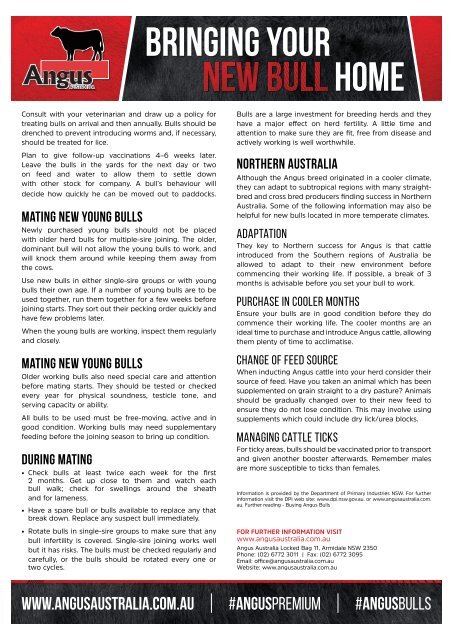Create successful ePaper yourself
Turn your PDF publications into a flip-book with our unique Google optimized e-Paper software.
Bringing your<br />
home<br />
Consult with your veterinarian and draw up a policy for<br />
treating bulls on arrival and then annually. Bulls should be<br />
drenched to prevent introducing worms and, if necessary,<br />
should be treated for lice.<br />
Plan to give follow-up vaccinations 4–6 weeks later.<br />
Leave the bulls in the yards for the next day or two<br />
on feed and water to allow them to settle down<br />
with other stock for company. A bull’s behaviour will<br />
decide how quickly he can be moved out to paddocks.<br />
Mating new young bulls<br />
Newly purchased young bulls should not be placed<br />
with older herd bulls for multiple-sire joining. <strong>The</strong> older,<br />
dominant bull will not allow the young bulls to work, and<br />
will knock them around while keeping them away from<br />
the cows.<br />
Use new bulls in either single-sire groups or with young<br />
bulls their own age. If a number of young bulls are to be<br />
used together, run them together for a few weeks before<br />
joining starts. <strong>The</strong>y sort out their pecking order quickly and<br />
have few problems later.<br />
When the young bulls are working, inspect them regularly<br />
and closely.<br />
Mating new young bulls<br />
Older working bulls also need special care and attention<br />
before mating starts. <strong>The</strong>y should be tested or checked<br />
every year for physical soundness, testicle tone, and<br />
serving capacity or ability.<br />
All bulls to be used must be free-moving, active and in<br />
good condition. Working bulls may need supplementary<br />
feeding before the joining season to bring up condition.<br />
During mating<br />
• Check bulls at least twice each week for the first<br />
2 months. Get up close to them and watch each<br />
bull walk; check for swellings around the sheath<br />
and for lameness.<br />
• Have a spare bull or bulls available to replace any that<br />
break down. Replace any suspect bull immediately.<br />
• Rotate bulls in single-sire groups to make sure that any<br />
bull infertility is covered. Single-sire joining works well<br />
but it has risks. <strong>The</strong> bulls must be checked regularly and<br />
carefully, or the bulls should be rotated every one or<br />
two cycles.<br />
Bulls are a large investment for breeding herds and they<br />
have a major effect on herd fertility. A little time and<br />
attention to make sure they are fit, free from disease and<br />
actively working is well worthwhile.<br />
Northern Australia<br />
Although the Angus breed originated in a cooler climate,<br />
they can adapt to subtropical regions with many straightbred<br />
and cross bred producers finding success in Northern<br />
Australia. Some of the following information may also be<br />
helpful for new bulls located in more temperate climates.<br />
Adaptation<br />
<strong>The</strong>y key to Northern success for Angus is that cattle<br />
introduced from the Southern regions of Australia be<br />
allowed to adapt to their new environment before<br />
commencing their working life. If possible, a break of 3<br />
months is advisable before you set your bull to work.<br />
Purchase in cooler months<br />
Ensure your bulls are in good condition before they do<br />
commence their working life. <strong>The</strong> cooler months are an<br />
ideal time to purchase and introduce Angus cattle, allowing<br />
them plenty of time to acclimatise.<br />
Change of feed source<br />
When inducting Angus cattle into your herd consider their<br />
source of feed. Have you taken an animal which has been<br />
supplemented on grain straight to a dry pasture? Animals<br />
should be gradually changed over to their new feed to<br />
ensure they do not lose condition. This may involve using<br />
supplements which could include dry lick/urea blocks.<br />
Managing Cattle Ticks<br />
For ticky areas, bulls should be vaccinated prior to transport<br />
and given another booster afterwards. Remember males<br />
are more susceptible to ticks than females.<br />
Information is provided by the Department of Primary Industries NSW. For further<br />
information visit the DPI web site: www.dpi.nsw.gov.au. or www.angusaustralia.com.<br />
au. Further reading - Buying Angus Bulls<br />
FOR FURTHER INFORMATION VISIT<br />
www.angusaustralia.com.au<br />
Angus Australia Locked Bag 11, Armidale NSW 2350<br />
Phone: (02) 6772 3011 | Fax: (02) 6772 3095<br />
Email: office@angusaustralia.com.au<br />
Website: www.angusaustralia.com.au<br />
www.angusaustralia.com.au | #Anguspremium | #angusbulls



